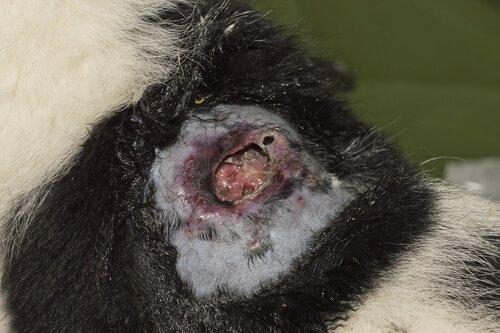Myiasis (Maggots) in Dogs: Causes, Symptoms, and Treatment

Myiasis is a disease that affects thousands of dogs every year. It’s unpleasant for animals and unpleasant to see. In today’s article you can learn about the causes, symptoms, and treatment for this disease. You already know that being informed about everything related to your pet’s health before something happens will provide him a better quality of life.
Myiasis in dogs: what is it?
It’s a parasitic disease that leaves an open superficial wound in which flies deposit their eggs. These eggs later become maggots that eat the animal’s skin tissue. When this takes place, they produce an enzyme that damages the animal’s skin. A maggot inside the wound keep it moist, and prevent it from healing. They even spread throughout the skin, causing the animal to feel a lot of pain.
Although these maggots generally eat the skin, they can enter the body through wounds and affect vital organs.
Causes of myiasis in dogs
Normally, in order for myiasis to develop, there must be an open wound which allows flies to penetrate the skin tissues. Flies are always lurking around, and quickly discover and lay their eggs in those areas.

The wounds are sometimes very small, caused by excessive licking, a scratch from a plant, a fight, or scratching. It always develops in areas where the dog cannot lick, because a dog could remove all the eggs with a simple lick.
Remember, that these maggots are always small in the beginning, but as they feed on the animal’s skin tissue, they grown, and the wound quickly get worse.
As the wound grows and becomes more visible, other flies might deposit their eggs on it, which in turn causes more damage to the dog. They could kill the animal, because maggots entering the body may reach the brain or other vital organs.
Symptoms of myiasis in dogs
Symptoms of an animal with myiasis are the following:
- Fever
- Pain
- Diarrhea
- Lack of appetite
- Boils
- Ulcers
- Itching and scratching
If you check your animal’s skin on a daily basis, you’ll see if there are any eggs or larvae on his body. You should specially check the center of the dog’s back, ears, and any area his tongue can’t reach. That way you can find them before they start damaging your pet’s tissues.
Diagnosis and Treatment for myiasis in dogs
To diagnosis a dog with this disease, only a superficial examination is necessary to see if there are any maggots. However, the vet will run some tests to make sure that the damage isn’t worse than what you can see.
To treat myiasis in dogs, you have to clean the wound. Before you do so, it’s a good idea to put a muzzle on the animal to prevent him from biting, because he might fell a lot of pain when you touch him.

The first thing you should do is very carefully cut the fur around the wound with a pair of scissors. Therefore, it will be easier to disinfect the wound. The vet will recommend a product to spray on it to help get the maggots to come out.
Once you have sprayed the product, remove the maggots one by one with a pair of tweezers. Once you make sure that there are none left, disinfect the wound with betadine or another medication, and soothe the pain with antibiotics that the vet prescribes.
The best way to keep the dog from licking or scratching the wound is by putting a bandage on it, or make him wear an Elizabethan collar if necessary. If you think you won’t be able to do it, then take the animal to a specialist so he can treat him. In such case, you would only have to give your pet antibiotics.
Myiasis is a disease that affects thousands of dogs every year. It’s unpleasant for animals and unpleasant to see. In today’s article you can learn about the causes, symptoms, and treatment for this disease. You already know that being informed about everything related to your pet’s health before something happens will provide him a better quality of life.
Myiasis in dogs: what is it?
It’s a parasitic disease that leaves an open superficial wound in which flies deposit their eggs. These eggs later become maggots that eat the animal’s skin tissue. When this takes place, they produce an enzyme that damages the animal’s skin. A maggot inside the wound keep it moist, and prevent it from healing. They even spread throughout the skin, causing the animal to feel a lot of pain.
Although these maggots generally eat the skin, they can enter the body through wounds and affect vital organs.
Causes of myiasis in dogs
Normally, in order for myiasis to develop, there must be an open wound which allows flies to penetrate the skin tissues. Flies are always lurking around, and quickly discover and lay their eggs in those areas.

The wounds are sometimes very small, caused by excessive licking, a scratch from a plant, a fight, or scratching. It always develops in areas where the dog cannot lick, because a dog could remove all the eggs with a simple lick.
Remember, that these maggots are always small in the beginning, but as they feed on the animal’s skin tissue, they grown, and the wound quickly get worse.
As the wound grows and becomes more visible, other flies might deposit their eggs on it, which in turn causes more damage to the dog. They could kill the animal, because maggots entering the body may reach the brain or other vital organs.
Symptoms of myiasis in dogs
Symptoms of an animal with myiasis are the following:
- Fever
- Pain
- Diarrhea
- Lack of appetite
- Boils
- Ulcers
- Itching and scratching
If you check your animal’s skin on a daily basis, you’ll see if there are any eggs or larvae on his body. You should specially check the center of the dog’s back, ears, and any area his tongue can’t reach. That way you can find them before they start damaging your pet’s tissues.
Diagnosis and Treatment for myiasis in dogs
To diagnosis a dog with this disease, only a superficial examination is necessary to see if there are any maggots. However, the vet will run some tests to make sure that the damage isn’t worse than what you can see.
To treat myiasis in dogs, you have to clean the wound. Before you do so, it’s a good idea to put a muzzle on the animal to prevent him from biting, because he might fell a lot of pain when you touch him.

The first thing you should do is very carefully cut the fur around the wound with a pair of scissors. Therefore, it will be easier to disinfect the wound. The vet will recommend a product to spray on it to help get the maggots to come out.
Once you have sprayed the product, remove the maggots one by one with a pair of tweezers. Once you make sure that there are none left, disinfect the wound with betadine or another medication, and soothe the pain with antibiotics that the vet prescribes.
The best way to keep the dog from licking or scratching the wound is by putting a bandage on it, or make him wear an Elizabethan collar if necessary. If you think you won’t be able to do it, then take the animal to a specialist so he can treat him. In such case, you would only have to give your pet antibiotics.
This text is provided for informational purposes only and does not replace consultation with a professional. If in doubt, consult your specialist.








